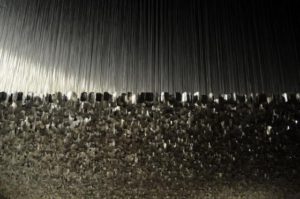The Vietnam War has been well documented in over 2,000 books and articles, and these efforts have yielded a lexicon of key events, figures, and outcomes from a plethora of noted historians, scholars, and participants of this quagmire. However, this war was also told through countless photographs that released their haunting stories in silent but profound ways. These photographs encapsulated fleeting moments in time and allowed the viewer to thoughtfully reflect upon the circumstances surrounding each image, but they also had the power to instantly outrage and provoke people to action—for better or for worse. The adage that a picture is worth a thousand words holds true when it comes to the telling of the Vietnam War. The photographs depicted here to illustrate and illuminate in graphic detail the stories that transcend the printed page. Many of these photographs are prize winning efforts that have become icons of Vietnam War reporting and storytelling. (Courtesy of the Associated Press archives.)
PHOTO GALLERY
Montagnards (1963)
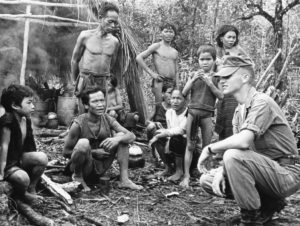 An American officer serving with the South Vietnam forces poses with a group of Montagnards in front of one of their provisional huts at a military camp in central Vietnam on November 17, 1962. The Montagnards were brought in by government troops from a village where they were used as the labor force by communist Viet Cong forces. The Montagnards were dark-skinned tribal people who lived in the highlands of central Vietnam with a population of about 700,000, and their alliance was sought by the government in their war with the Viet Cong. By the end of 1963, the United States would have over 16,000 military personnel stationed in Vietnam serving as combat troops against the Viet Cong, but the CIA and State Department civilian advisors, along with junior military officers, were not optimistic that the South Vietnamese would be able to turn them back.
An American officer serving with the South Vietnam forces poses with a group of Montagnards in front of one of their provisional huts at a military camp in central Vietnam on November 17, 1962. The Montagnards were brought in by government troops from a village where they were used as the labor force by communist Viet Cong forces. The Montagnards were dark-skinned tribal people who lived in the highlands of central Vietnam with a population of about 700,000, and their alliance was sought by the government in their war with the Viet Cong. By the end of 1963, the United States would have over 16,000 military personnel stationed in Vietnam serving as combat troops against the Viet Cong, but the CIA and State Department civilian advisors, along with junior military officers, were not optimistic that the South Vietnamese would be able to turn them back.
Source: http://www.theatlantic.com/photo/2015/03/the-vietnam-war-part-i-early-years-and-escalation/389054/
The Burning Monk (1963)
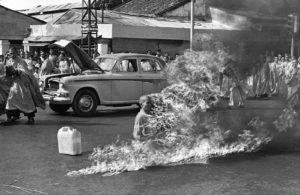
In June of 1963, Vietnamese Mahayana Buddhist monk, Thích Quang Duc, burned himself to death at a busy intersection in Saigon. He was attempting to show that to fight all forms of oppression on equal terms, Buddhism too, needed to have its martyrs. The self-immolation was done in protest to pro-Catholic policies that discriminated against Buddhists and were enacted by the ruling regime of South Vietnam led by president Ngo Dihn Diem. In particular, this act of protest was a response to the banning of the Buddhist flag and the disrespect that Diem had shown Buddhists shortly thereafter by holding a public ceremony to display Catholic crosses. Earlier in his rule, Diem had already dedicated Vietnam to Jesus and the Catholic Church; he created a growing resentment among Buddhists by doing so. This clash of religions became one of the underlying issues of South Vietnam and eventually led to the formation of a coup whose leader would not alienate Buddhists (who comprised 70-90% of Vietnam’s population). Photographer Malcolm Browne captured the scene in Saigon for the Associated Press, and the stark black and white image quickly became an iconic visual of the turbulent 1960s.
Source: http://rarehistoricalphotos.com/the-burning-monk-1963/
Casualty of War (1964)
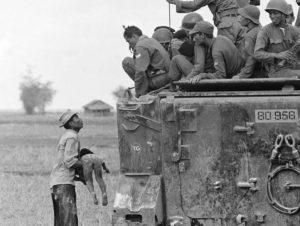 A father holds the body of his child as South Vietnamese Army Rangers look down from their armored vehicle on March 19, 1964. The child was killed as government forces pursued guerrillas into a village near the Cambodian border. Estimates of civilian casualties range from 1.3 to 2.5 million, and experts believe that civilian deaths constituted about 30 to 50 percent of the death toll. This tally does not include Laotian and Cambodian deaths due to combat excursions by U.S. and South Vietnamese forces.
A father holds the body of his child as South Vietnamese Army Rangers look down from their armored vehicle on March 19, 1964. The child was killed as government forces pursued guerrillas into a village near the Cambodian border. Estimates of civilian casualties range from 1.3 to 2.5 million, and experts believe that civilian deaths constituted about 30 to 50 percent of the death toll. This tally does not include Laotian and Cambodian deaths due to combat excursions by U.S. and South Vietnamese forces.
Source: http://www.theatlantic.com/photo/2015/03/the-vietnam-war-part-i-early-years-and-escalation/389054/
March Against the Vietnam War (1965)
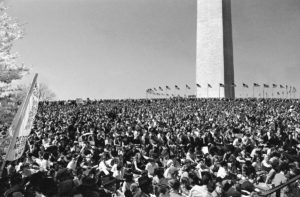 The student activist group, Students for a Democratic Society (SDS), held its first anti-Vietnam War protest rally in Washington, D.C. On April 17, 1965, tens of thousands of people attended a rally on the grounds of the Washington Monument in Washington to hear Ernest Gruening, a Democratic senator from Alaska, and other speakers discuss U.S. policy in Vietnam. Senator Gruening was one of two senators who voted against the Tonkin Gulf Resolution that gave credence to U.S. involvement in Vietnam at the request of LBJ. The rally followed picketing of the White House by students demanding an end to Vietnam fighting.
The student activist group, Students for a Democratic Society (SDS), held its first anti-Vietnam War protest rally in Washington, D.C. On April 17, 1965, tens of thousands of people attended a rally on the grounds of the Washington Monument in Washington to hear Ernest Gruening, a Democratic senator from Alaska, and other speakers discuss U.S. policy in Vietnam. Senator Gruening was one of two senators who voted against the Tonkin Gulf Resolution that gave credence to U.S. involvement in Vietnam at the request of LBJ. The rally followed picketing of the White House by students demanding an end to Vietnam fighting.
Source: http://www.theatlantic.com/photo/2015/03/the-vietnam-war-part-i-early-years-and-escalation/389054/
Teach-Ins (1965)
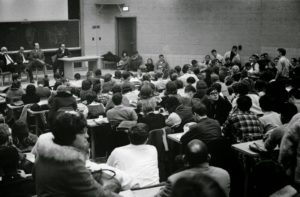 “Teach ins” were popularized during the U.S. government’s involvement in Vietnam. The first teach-in, which was held overnight at the University of Michigan in March 24-25, 1965, began with a discussion of the Vietnam War draft and ended in the early morning with a speech by philosopher Arnold Kaufman. The original teach-in, which was organized and led by faculty on the Ann Arbor campus, addressed one of the most pressing public issues of the day: our nation’s rapidly escalating war in Vietnam. Drawing more than 3,000 students, faculty, and other participants, the event proved highly successful, and the teach-in format that was pioneered at U-M was replicated at countless colleges and universities across the country over the next several months and years.
“Teach ins” were popularized during the U.S. government’s involvement in Vietnam. The first teach-in, which was held overnight at the University of Michigan in March 24-25, 1965, began with a discussion of the Vietnam War draft and ended in the early morning with a speech by philosopher Arnold Kaufman. The original teach-in, which was organized and led by faculty on the Ann Arbor campus, addressed one of the most pressing public issues of the day: our nation’s rapidly escalating war in Vietnam. Drawing more than 3,000 students, faculty, and other participants, the event proved highly successful, and the teach-in format that was pioneered at U-M was replicated at countless colleges and universities across the country over the next several months and years.
Source: https://sites.lsa.umich.edu/teach-in-50/home/
Going Home (1965)
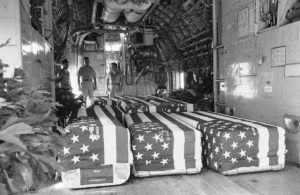 Flag-draped coffins of eight American servicemen killed on February 7, 1965, in attacks on U.S. military installations in South Vietnam are placed in a transport plane in Saigon for their return flight home. Funeral services were held at the Saigon Airport with U.S. Ambassador Maxwell D. Taylor and Vietnamese officials attending. Military personnel killed in Vietnam were flown to Dover Air Force Base and released to families for proper burial. It is estimated that over 1,968 American military personnel were killed in Vietnam in 1965.
Flag-draped coffins of eight American servicemen killed on February 7, 1965, in attacks on U.S. military installations in South Vietnam are placed in a transport plane in Saigon for their return flight home. Funeral services were held at the Saigon Airport with U.S. Ambassador Maxwell D. Taylor and Vietnamese officials attending. Military personnel killed in Vietnam were flown to Dover Air Force Base and released to families for proper burial. It is estimated that over 1,968 American military personnel were killed in Vietnam in 1965.
Source: http://www.theatlantic.com/photo/2015/03/the-vietnam-war-part-i-early-years-and-escalation/389054/
A Young Private at Da Nang (1965)
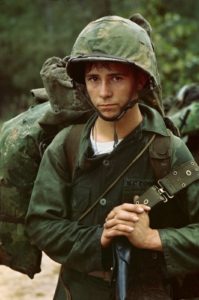 This photo depicts a young U.S. Marine being staged at Da Nang in 1965. Da Nang was considered by military strategists to be a key piece of real estate early in the war. Situated on flat, sandy ground on the south side of the major port city of Da Nang, the area was ideal for an airfield, having unobstructed approaches to its north/south runways. The base became a joint operating airfield when U.S. Forces came to the aid of the South Vietnamese. The combat unit who landed on Da Nang to protect the airbase was the first U.S. ground unit to land on South Vietnam. During the early years of the war, many American servicemen supported the U.S. government’s decision to become involved in Vietnam. They believed it was important to stop the spread of communism in Southeast Asia. As a result, the morale of American troops was fairly high at the onset of the war. However, by the late 1960s and early 1970s both the morale and performance of the U.S. forces declined rapidly.
This photo depicts a young U.S. Marine being staged at Da Nang in 1965. Da Nang was considered by military strategists to be a key piece of real estate early in the war. Situated on flat, sandy ground on the south side of the major port city of Da Nang, the area was ideal for an airfield, having unobstructed approaches to its north/south runways. The base became a joint operating airfield when U.S. Forces came to the aid of the South Vietnamese. The combat unit who landed on Da Nang to protect the airbase was the first U.S. ground unit to land on South Vietnam. During the early years of the war, many American servicemen supported the U.S. government’s decision to become involved in Vietnam. They believed it was important to stop the spread of communism in Southeast Asia. As a result, the morale of American troops was fairly high at the onset of the war. However, by the late 1960s and early 1970s both the morale and performance of the U.S. forces declined rapidly.
Source: http://rarehistoricalphotos.com/young-private-da-nang-vietnam-1965/
An American Soldier in Nam (1965)
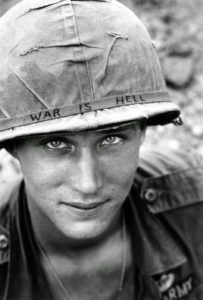
AP photojournalist Horst Faas took this iconic photo on June 18, 1965, during the Vietnam War with the 173rd Airborne Brigade Battalion on defense duty at Phouc Vinh airstrip in South Vietnam. The headband message “War is Hell” typified an acerbic attitude of many young American soldiers who were likely drafted and sent to the remote southeast Asian jungles to engage in deadly and terrifying combat. Many of the soldiers wrote graffiti on their helmets with inscriptions of their attitudes about where they were and why they were there. The contradicting nature of this photo is what makes it iconic: the bright and handsome soldier with an engaging smile on his face clashes with the somber text on his helmet. Though his face conveys a youthful innocence, his helmet indicates otherwise, leaving little doubt that he has witnessed the horrors of war firsthand.
The identity of the soldier was unknown for many decades until recently when he was identified as Larry Wayne Chaffin from St. Louis. He served with that brigade in Vietnam for exactly one year beginning in May 1965. He was 19 years old when the photo was taken. Chaffin had many problems adjusting to civilian life when he returned from Vietnam. He died in 1985, at the age of 39, from complications that arose from diabetes, a condition that might have been instigated by his exposure to Agent Orange while serving in Vietnam.
Source: http://rarehistoricalphotos.com/soldier-war-is-hell-vietnam-1965/
Exodus: A Mother and Her Children Escape (1965)
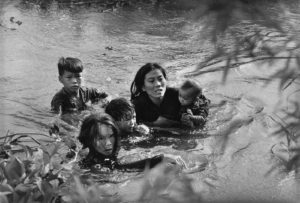 In this photo, a South Vietnamese mother flees through a river to escape a recent bombing of her village. She and her four children were forced to leave their village, Qui Nhon, near Quinbonso after the U.S. Air Force had asked all inhabitants to evacuate the village because the Vietcong had been using it as a base camp to fire at the U.S. Marines. The attack was part of an elaborate clearing operation, whose purpose it was to drive the Vietcong members out of the coastal area in South Vietnam. The assault was named Operation Piranha and employed more than 5,000 troops. In each village that was believed to shelter Vietcong guerillas, women and children were advised to leave before the attack would commence. The Communist fighters often used women and children as a screen for their operations.
In this photo, a South Vietnamese mother flees through a river to escape a recent bombing of her village. She and her four children were forced to leave their village, Qui Nhon, near Quinbonso after the U.S. Air Force had asked all inhabitants to evacuate the village because the Vietcong had been using it as a base camp to fire at the U.S. Marines. The attack was part of an elaborate clearing operation, whose purpose it was to drive the Vietcong members out of the coastal area in South Vietnam. The assault was named Operation Piranha and employed more than 5,000 troops. In each village that was believed to shelter Vietcong guerillas, women and children were advised to leave before the attack would commence. The Communist fighters often used women and children as a screen for their operations.
This picture was 1966 World Press Photo of the Year. After he won the prize, photographer Kyoichi Sawada searched and located the family in the picture and gave them all the prize money along with a copy of the photograph. Four years later, while in working in Cambodia, Sawada died in the field doing what he loved most.
Source: http://rarehistoricalphotos.com/mother-children-river-vietnam-1965/
Rolling Thunder (1965)
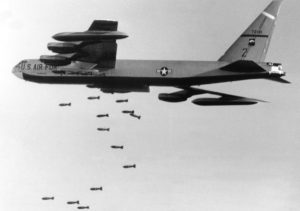 During the Vietnam War (1954-75), as part of the strategic bombing campaign known as Operation Rolling Thunder, U.S. military aircraft attacked targets throughout North Vietnam from March 1965 to October 1968. This massive bombardment was intended to put military pressure on North Vietnam’s Communist leaders and reduce their capacity to wage war against the U.S. supported government of South Vietnam. Operation Rolling Thunder marked the first sustained American assault on North Vietnamese territory and thus represented a major expansion of U.S. involvement in the Vietnam War. Historians differ in their assessments of the strategic value of Operation Rolling Thunder. Some claim that the bombing campaign came close to crippling North Vietnam’s capacity to wage war, while others contend that the campaign’s effectiveness was limited. This AP photo depicts a strategic air command B-52 bomber with externally mounted 750-pound bombs heading towards its target on November 2, 1965 (fifty-six miles northwest of Saigon near Tay Ninh).
During the Vietnam War (1954-75), as part of the strategic bombing campaign known as Operation Rolling Thunder, U.S. military aircraft attacked targets throughout North Vietnam from March 1965 to October 1968. This massive bombardment was intended to put military pressure on North Vietnam’s Communist leaders and reduce their capacity to wage war against the U.S. supported government of South Vietnam. Operation Rolling Thunder marked the first sustained American assault on North Vietnamese territory and thus represented a major expansion of U.S. involvement in the Vietnam War. Historians differ in their assessments of the strategic value of Operation Rolling Thunder. Some claim that the bombing campaign came close to crippling North Vietnam’s capacity to wage war, while others contend that the campaign’s effectiveness was limited. This AP photo depicts a strategic air command B-52 bomber with externally mounted 750-pound bombs heading towards its target on November 2, 1965 (fifty-six miles northwest of Saigon near Tay Ninh).
Source: http://www.history.com/topics/vietnam-war/operation-rolling-thunder
Waterprobe (1966)
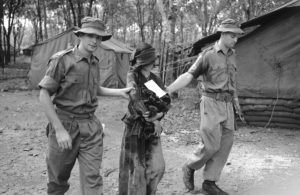 A 23-year-old Vietnamese girl was captured by an Australian patrol thirty feet below ground at the end of a maze of tunnels that were ten miles west of the headquarters of the Australian task force (forty miles southeast of Saigon). The woman was crouched over a World War II radio set. About seven male Viet Cong took off when the Australians appeared, but the woman remained and appeared to be trying to conceal the radio set. She was taken back to the Australian headquarters and under sharp interrogation (which included a “waterprobe”), she confessed to being a Viet Cong nurse in the village of Hoa Long and stated that she had been in the tunnel for 10 days. The Australians did not believe her because she seemed to lack any medical knowledge. They thought that she may have possibly been the leader of the political cell in Hoa Long. The picture was taken on October 29, 1966, as she was being led away after interrogation, clothes soaked from the “waterprobe.”
A 23-year-old Vietnamese girl was captured by an Australian patrol thirty feet below ground at the end of a maze of tunnels that were ten miles west of the headquarters of the Australian task force (forty miles southeast of Saigon). The woman was crouched over a World War II radio set. About seven male Viet Cong took off when the Australians appeared, but the woman remained and appeared to be trying to conceal the radio set. She was taken back to the Australian headquarters and under sharp interrogation (which included a “waterprobe”), she confessed to being a Viet Cong nurse in the village of Hoa Long and stated that she had been in the tunnel for 10 days. The Australians did not believe her because she seemed to lack any medical knowledge. They thought that she may have possibly been the leader of the political cell in Hoa Long. The picture was taken on October 29, 1966, as she was being led away after interrogation, clothes soaked from the “waterprobe.”
Source: http://www.theatlantic.com/photo/2015/03/the-vietnam-war-part-i-early-years-and-escalation/389054/
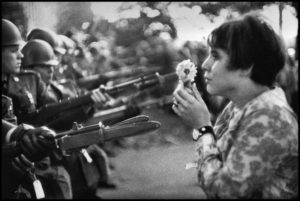
American high-school student, Jan Rose Kasmir, confronts the American National Guard during an anti-Vietnam march in Washington on October 21, 1967. Seventeen-year-old Kasmar is shown clasping a chrysanthemum and gazing at the bayonet wielding guardsmen outside the Pentagon. This photo became a symbol of the flower power movement. The march itself, led by several thousand anti-war activists, was instrumental in turning public opinion against the U.S. war in Vietnam.
Source: http://time.com/3841060/iconic-vietnam-war-photos/
Flower Power at the Pentagon (1967)
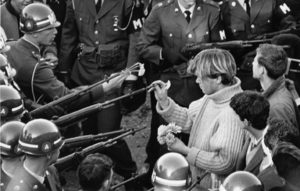 This historic photograph was taken by American photographer Bernie Boston for the now-defunct Washington Star newspaper. Taken on October 21, 1967, during the National Mobilization Committee to End the War in Vietnam march to the Pentagon, the iconic photo shows a Vietnam War protester, George Harris, placing a carnation into the barrel of a rifle held by a soldier of the 503rd Military Police Battalion. Boston credits timing, location and luck for this timely photograph, but his editor at the time did not think the photo was worthy of the front page and buried it deep in the front section. It was not until Boston started to enter some of his work in photo competitions that he received recognition for this iconic photo. This photograph was nominated for the 1967 Pulitzer Prize for photography.
This historic photograph was taken by American photographer Bernie Boston for the now-defunct Washington Star newspaper. Taken on October 21, 1967, during the National Mobilization Committee to End the War in Vietnam march to the Pentagon, the iconic photo shows a Vietnam War protester, George Harris, placing a carnation into the barrel of a rifle held by a soldier of the 503rd Military Police Battalion. Boston credits timing, location and luck for this timely photograph, but his editor at the time did not think the photo was worthy of the front page and buried it deep in the front section. It was not until Boston started to enter some of his work in photo competitions that he received recognition for this iconic photo. This photograph was nominated for the 1967 Pulitzer Prize for photography.
Source: http://www.washingtonpost.com/wp-dyn/content/article/2008/01/23/AR2008012303713.html
Saigon Execution: Murder of a Vietcong by Saigon Police Chief (1968)
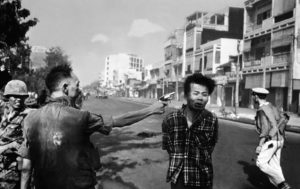 This photo captures the stark reality of wartime justice. Saigon police chief, Nguyen Ngoc Loan raises his sidearm and executes Viet Cong operative Nguyen Van Lem in the head. Shortly after the execution, the chief had told reporters that, “These guys kill a lot of our people, and I think Buddha will forgive me.” Captured on NBC TV cameras and by AP photographer Eddie Adams, the picture and film footage flashed around the world and quickly became a symbol of the Vietnam War’s brutality. Eddie Adams’ picture was especially striking, as the moment was frozen is one almost at the instant of death. Taken a split second after the trigger was pulled, Lem’s final expression is one of pain as the bullet rips through his head. A closer look of the photo actually reveals the bullet exiting his skull. This photograph would not only earn Adams a Pulitzer Prize in 1969, but it also went a long way toward souring the opinions of the American people with regards to the Vietnam War. But for all the image’s political impact, the situation was not as black-and-white as it was rendered to be. What Adams’ photograph does not reveal is that the man being shot (named Nguyen Van Lem) was the captain of a Viet Cong “revenge squad” that had executed dozens of unarmed civilians earlier that same day. Regardless, the picture instantly became an icon of the war’s savagery and made General Nguyen Ngoc Loan, the official who pulled the trigger, its iconic villain.
This photo captures the stark reality of wartime justice. Saigon police chief, Nguyen Ngoc Loan raises his sidearm and executes Viet Cong operative Nguyen Van Lem in the head. Shortly after the execution, the chief had told reporters that, “These guys kill a lot of our people, and I think Buddha will forgive me.” Captured on NBC TV cameras and by AP photographer Eddie Adams, the picture and film footage flashed around the world and quickly became a symbol of the Vietnam War’s brutality. Eddie Adams’ picture was especially striking, as the moment was frozen is one almost at the instant of death. Taken a split second after the trigger was pulled, Lem’s final expression is one of pain as the bullet rips through his head. A closer look of the photo actually reveals the bullet exiting his skull. This photograph would not only earn Adams a Pulitzer Prize in 1969, but it also went a long way toward souring the opinions of the American people with regards to the Vietnam War. But for all the image’s political impact, the situation was not as black-and-white as it was rendered to be. What Adams’ photograph does not reveal is that the man being shot (named Nguyen Van Lem) was the captain of a Viet Cong “revenge squad” that had executed dozens of unarmed civilians earlier that same day. Regardless, the picture instantly became an icon of the war’s savagery and made General Nguyen Ngoc Loan, the official who pulled the trigger, its iconic villain.
Source: http://rarehistoricalphotos.com/saigon-execution-murder-vietcong-saigon-1968/
LBJ’s Anguish (1968)
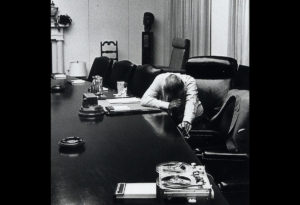 The assassination of President Kennedy laid the problems of Vietnam squarely on Johnson’s desk. Unwilling to deviate from Kennedy’s approach to the conflict, Johnson vowed not to lose the war. If anything, he encouraged his closest advisers to work even harder at helping South Vietnam prosecute the counterinsurgency. In this AP photograph taken at the White House on July 31, 1968, U.S. President Lyndon B. Johnson listens to a tape recording from his son-in-law, Captain Charles Robb. At the time, Robb was a U.S. Marine Corps company commander in Vietnam and was later awarded the Bronze Star.
The assassination of President Kennedy laid the problems of Vietnam squarely on Johnson’s desk. Unwilling to deviate from Kennedy’s approach to the conflict, Johnson vowed not to lose the war. If anything, he encouraged his closest advisers to work even harder at helping South Vietnam prosecute the counterinsurgency. In this AP photograph taken at the White House on July 31, 1968, U.S. President Lyndon B. Johnson listens to a tape recording from his son-in-law, Captain Charles Robb. At the time, Robb was a U.S. Marine Corps company commander in Vietnam and was later awarded the Bronze Star.
Source: http://www.theatlantic.com/photo/2015/03/the-vietnam-war-part-ii-losses-and-withdrawal/389192/
Nixon Visits the Troops (1969)
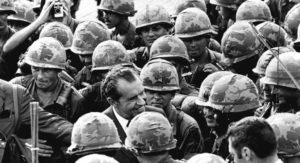 A GI gets a closeup photo as President Nixon meets with troops of the 1st Infantry Division at Di An (12 miles northeast of Saigon) on his first presidential visit to South Vietnam on July 30, 1969. Nixon, like his predecessors, Johnson and Kennedy, was bound and determined not to lose Vietnam.
A GI gets a closeup photo as President Nixon meets with troops of the 1st Infantry Division at Di An (12 miles northeast of Saigon) on his first presidential visit to South Vietnam on July 30, 1969. Nixon, like his predecessors, Johnson and Kennedy, was bound and determined not to lose Vietnam.
Source: http://www.theatlantic.com/photo/2015/03/the-vietnam-war-part-ii-losses-and-withdrawal/389192/
Mouth to Mouth (1969)
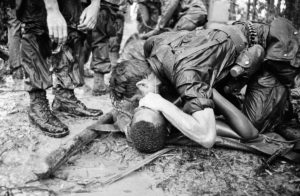 A trooper of the 101st Airborne Division attempts to save the life of a buddy at Dong Ap Bia Mountain, near South Vietnam’s A Shau Valley on May 19, 1969. The man was seriously wounded in the last of repeated attempts by U.S. forces to capture enemy positions there.
A trooper of the 101st Airborne Division attempts to save the life of a buddy at Dong Ap Bia Mountain, near South Vietnam’s A Shau Valley on May 19, 1969. The man was seriously wounded in the last of repeated attempts by U.S. forces to capture enemy positions there.
Source: http://www.theatlantic.com/photo/2015/03/the-vietnam-war-part-ii-losses-and-withdrawal/389192/
Kent State Shootings (1970)
 On April 30, 1970, President Richard M. Nixon appeared on national television to announce the invasion of Cambodia by the United States and the need to draft 150,000 more soldiers for an expansion of the Vietnam War effort. This provoked massive protests on campuses throughout the country. At Kent State University in Ohio, protesters launched a demonstration that included setting fire to the ROTC building, prompting the governor of Ohio to dispatch 900 National Guardsmen to the campus. During an altercation on May 4, twenty-eight guardsmen opened fire on a crowd, killing four students and wounding nine. Following the killings, the unrest across the country escalated even further and nearly five-hundred colleges were shut down or disrupted by protests. Despite the public outcry, the Justice Department initially declined to conduct a grand jury investigation. A report by the President’s Commission on Campus Unrest did acknowledge, however, that the action of the guardsmen had been “unnecessary, unwarranted, and inexcusable.” Eventually, a grand jury indicted eight of the guardsmen, but the charges were dismissed for lack of evidence. In their coverage of the events at Kent State, the media used a photo, taken by a fellow student, of a woman kneeling in anguish, arms upraised, beside one of the slain students. This Pulitzer Prize–winning image soon became a symbol of the social upheaval of the time.
On April 30, 1970, President Richard M. Nixon appeared on national television to announce the invasion of Cambodia by the United States and the need to draft 150,000 more soldiers for an expansion of the Vietnam War effort. This provoked massive protests on campuses throughout the country. At Kent State University in Ohio, protesters launched a demonstration that included setting fire to the ROTC building, prompting the governor of Ohio to dispatch 900 National Guardsmen to the campus. During an altercation on May 4, twenty-eight guardsmen opened fire on a crowd, killing four students and wounding nine. Following the killings, the unrest across the country escalated even further and nearly five-hundred colleges were shut down or disrupted by protests. Despite the public outcry, the Justice Department initially declined to conduct a grand jury investigation. A report by the President’s Commission on Campus Unrest did acknowledge, however, that the action of the guardsmen had been “unnecessary, unwarranted, and inexcusable.” Eventually, a grand jury indicted eight of the guardsmen, but the charges were dismissed for lack of evidence. In their coverage of the events at Kent State, the media used a photo, taken by a fellow student, of a woman kneeling in anguish, arms upraised, beside one of the slain students. This Pulitzer Prize–winning image soon became a symbol of the social upheaval of the time.
Source: http://www.history.com/topics/vietnam-war/kent-state
Female Viet Cong Guerrilla (1972)
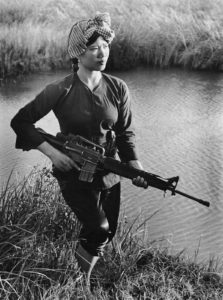 Her name is Lam Thi Dep (Dep means beautiful in Vietnamese), and the picture was taken in 1972 at Soc Trang Province by Vietnamese journalist Minh Truong. “You could find women like her almost everywhere during the war,” said the photographer. “She was only 24 years old but had been widowed twice. Both her husbands were soldiers.” In this photograph, Dep is wielding an M-16, the standard issued American soldier’s rifle. Usually, these type of photos were taken for propaganda purposes by the North Vietnamese as their women were deeply involved on all levels of the military campaign throughout the war. North Vietnamese women were enlisted and actively fought in the combat zone against American-led troops in the jungle. They also provided manual labor to keep the Ho Chi Minh trail open and served as cooks for the troops while some served as “comfort women” for the communist fighters. These women also worked in the rice fields in North Vietnam and in Viet Cong–controlled farming areas in South Vietnam’s Mekong Delta region, providing food for their families and the war effort.
Her name is Lam Thi Dep (Dep means beautiful in Vietnamese), and the picture was taken in 1972 at Soc Trang Province by Vietnamese journalist Minh Truong. “You could find women like her almost everywhere during the war,” said the photographer. “She was only 24 years old but had been widowed twice. Both her husbands were soldiers.” In this photograph, Dep is wielding an M-16, the standard issued American soldier’s rifle. Usually, these type of photos were taken for propaganda purposes by the North Vietnamese as their women were deeply involved on all levels of the military campaign throughout the war. North Vietnamese women were enlisted and actively fought in the combat zone against American-led troops in the jungle. They also provided manual labor to keep the Ho Chi Minh trail open and served as cooks for the troops while some served as “comfort women” for the communist fighters. These women also worked in the rice fields in North Vietnam and in Viet Cong–controlled farming areas in South Vietnam’s Mekong Delta region, providing food for their families and the war effort.
Source: http://rarehistoricalphotos.com/female-viet-cong-guerrila-1972/
The Napalm Girl (1972)
![]()
After an aerial napalm attack on suspected Viet Cong hiding places on June 8, 1972, South Vietnamese soldiers and terrified children run down Route 1 near Trang Bang village. Among them is 9 year-old Kim Phuc (near center) who was severely burned when a South Vietnamese plane misidentified friendly troops and civilians for enemies and dropped the flaming napalm on them. The terrified girl had ripped off her burning clothes while fleeing.
The children from left to right are: Phan Thanh Tam (younger brother of Kim Phuc who lost an eye); Phan Thanh Phouc (youngest brother of Kim Phuc); Kim Phuc; and Kim’s cousins Ho Van Bon and Ho Thi Ting. Behind them are soldiers of the Vietnam Army 25th Division. (AP Photo/Nick Ut)
Source: http://time.com/3841060/iconic-vietnam-war-photos/
A Time for Prayer (1973)
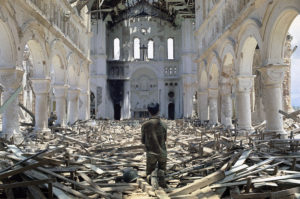 A South Vietnamese Marine takes a moment to pray in the deserted Catholic Church located in La Vang, a town south of Quang Tri City, on July 6, 1972. At the time, the majority of the population in Vietnam were Buddhists while Catholics were a part of the minority. And many Catholics who resided in the South during the Vietnam War were originally from the North having fled the Viet Minh.
A South Vietnamese Marine takes a moment to pray in the deserted Catholic Church located in La Vang, a town south of Quang Tri City, on July 6, 1972. At the time, the majority of the population in Vietnam were Buddhists while Catholics were a part of the minority. And many Catholics who resided in the South during the Vietnam War were originally from the North having fled the Viet Minh.
Under the leadership of President Ngo Dinh Diem, who was Catholic, many Buddhists claimed that the government’s policies were steeped in religious bias, which highly antagonized the Buddhist majority. The Diem government favored Catholics in public service and military promotions, in the allocation of land, in business dealings and tax concessions. It was not uncommon for many officers in the Army of the Republic of Vietnam to convert to Catholicism to better their prospects. The Catholic Church was the largest landowner in the country, and its holdings were exempt from reform and given extra property acquisition rights, while restrictions against Buddhism remained enforced.
Source: http://www.theatlantic.com/photo/2015/03/the-vietnam-war-part-ii-losses-and-withdrawal/389192/
Buddhist Pagoda Bell (1973)
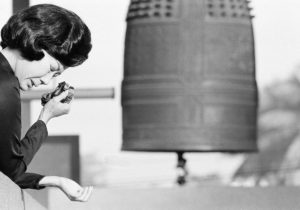 A South Vietnamese widow cries as a bell at a Saigon Buddhist pagoda tolls the ceasefire at 8 a.m., on January 28, 1973 (Saigon time). The United States had begun drastically reducing forces in the country, and, following the Paris Peace Accords of 1973, the last remaining American troops withdrew in March of 1973.
A South Vietnamese widow cries as a bell at a Saigon Buddhist pagoda tolls the ceasefire at 8 a.m., on January 28, 1973 (Saigon time). The United States had begun drastically reducing forces in the country, and, following the Paris Peace Accords of 1973, the last remaining American troops withdrew in March of 1973.
Source: http://www.theatlantic.com/photo/2015/03/the-vietnam-war-part-ii-losses-and-withdrawal/389192/
Burst of Joy (1973)
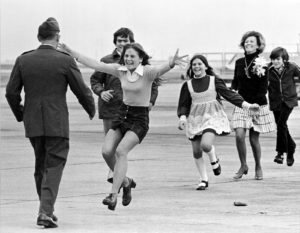 After spending more than five years in a North Vietnamese camp, Lt. Col. Robert L. Stirm is reunited with his family at Travis AFB on March 13, 1973. “Burst of Joy” is a Pulitzer Prize-winning photograph by Associated Press photographer Slava “Sal” Veder. The photograph came to symbolize the end of United States involvement in the Vietnam War, and it embodies the prevailing sentiment of that particular period in history: it was time to begin the process of healing after enduring the torment of war.
After spending more than five years in a North Vietnamese camp, Lt. Col. Robert L. Stirm is reunited with his family at Travis AFB on March 13, 1973. “Burst of Joy” is a Pulitzer Prize-winning photograph by Associated Press photographer Slava “Sal” Veder. The photograph came to symbolize the end of United States involvement in the Vietnam War, and it embodies the prevailing sentiment of that particular period in history: it was time to begin the process of healing after enduring the torment of war.
Prisoners of war freed from the prison camps in North Vietnam landed at Travis Air Force Base in California, and even though there were only 20 POWs aboard the plane, almost 400 family members turned up for the homecoming. As a photographer, Veder was part of a big press showing, and he remembered how he “…could feel the energy and the raw emotion in the air.” The centerpiece of the photograph is Stirm’s 15-year-old daughter Lorrie who is excitedly greeting her father with outstretched arms as the rest of the family follows closely behind her.
Source: http://rarehistoricalphotos.com/burst-joy/
Presidential Palace (1975)
![]()
A North Vietnamese tank rolls through the gate of the Presidential Palace in Saigon on April 30, 1975, signifying the fall of South Vietnam. The Socialist Republic of Vietnam was formed in 1976, uniting the North and South. Under the rule of a new government, millions of South Vietnamese were sent to reeducation camps while millions more fled the country on their own. This mass exodus will eventually lead to the Indochina refugee crisis that will last through the next quarter of a century.
Source: http://www.theatlantic.com/photo/2015/03/the-vietnam-war-part-ii-losses-and-withdrawal/389192/
“Above and Beyond “is comprised of 58,307 dog tags. Each dog tag represents the death of military personnel in the Vietnam War and is arranged in date order of death. And, each dog tag shows their name, date of death and military branch.
Above and Beyond was commissioned by the National Veterans Art Museum and created by veteran artists: Rick Steinbock, Ned Broderick, Joe Fornelli and Mike Helbing. It was originally installed at 1801 S. Indiana Ave. on May 26, 2001 to coincide with Chicago’s Memorial Day parade. Above and Beyond was created over a 2-year period as each dog tag was stamped by hand using a former military Graphotype machine. Above and Beyond is the only memorial other than The Wall in Washington, D.C. to list all those killed in action during the Vietnam War. Additionally, it includes one black dog tag. This serves to remind us of the soldiers who died from conditions related to service during the Vietnam War.
Above and Beyond is part of the National Veteran’s Art Museum Collection, and is on extended exhibition at the Harold Washington Library Center through April 15, 2020.
Above and Beyond, (13 ft. X 32 ft.) Copyright 2016 © Selected work from permanent collection,
Courtesy of National Veterans Art Museum.
